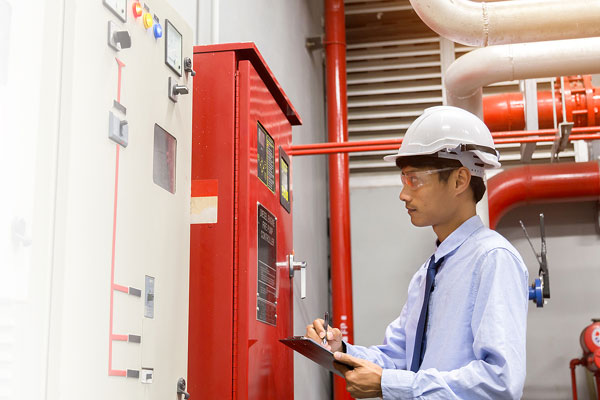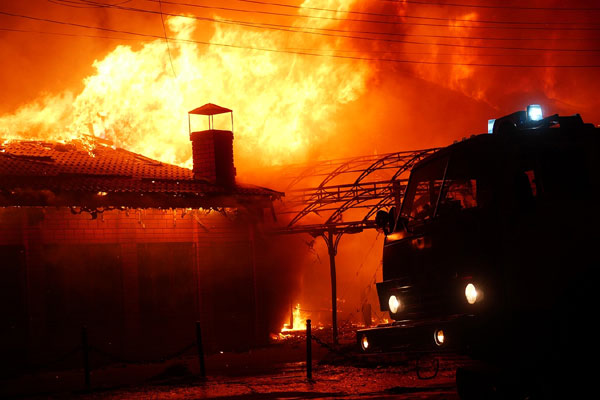



Fire Alarm Maintenance Certificates
Regular maintenance and checks of fire alarm systems are essential for every business. Survey JEM™ makes the process of creating the final certificate as quick and easy as possible. Survey JEM™ benefits from over twenty years of knowledge and experience developing online surveying and reporting software.
Information collected during the testing process is recorded in real time and displayed in an easy to use layout. When the engineer issues the certificate the business owner can be automatically notifed by email. They can accept the certificate online with a few clicks or, if they prefer, they can access fire equipment maintenance information for a whole property portfolio.
Fire is one of the most serious risks that businesses face. In the event of a fire, you risk losing more than just your property; you may risk the lives of yourself, your employees and even visitors to your business premises. A lack of compliant fire safety measures, including an effective and well maintained fire alarm system, can easily result in material and financial losses, as well as the loss of life.
Having a fully operative fire alarm security system is clearly the best way to help keep you and your property safe. The fire alarm system should give an early warning of the threat that fire poses and offers you enough time to evacuate the premises and call the fire service before the fire gets out of control. Having said that, a fire alarm system that is never checked and maintained is likely to lull you into a false sense of security, as it could easily fail to operate when it really should, costing you dearly.
Fire alarm systems: More than just a good idea
Fire alarms are a vital part of any business and there are certain laws stating that every business, no matter what size, must have a suitable fire alarm system.
The United Kingdom fire alarm regulations state that you are responsible for fire safety in your business premises if you are the owner or employer.
The way a fire alarm system should work
A fully operative fire alarm system works by way of sensors that detect smoke, heat or an increase in the levels of carbon monoxide. When the sensors pick up elevated levels of the above, the system should trigger an audible alarm that warns others in and around the premises. The successful activation of a fire alarm system should also release any open fire doors that are held open, allowing them to close swiftly and efficiently. In general, fire doors should only be held open by approved latches that are released upon the activation of a fire alarm, never by other means such as wooden wedges or fire extinguishers, which unfortunately seems to be a common, albeit dangerous practice.
Most modern fire alarm systems tend to be wireless and the heat or smoke detectors transmit the signals to a control panel wirelessly. Heat detectors use thermostats which sense the presence of excess heat. There are also specific sensors that detect the increase of carbon monoxide levels. Smoke detectors use photo electricity or ionization to sense the presence of smoke within the monitored area.
Once the fire alarm systems main control panel receives the signal it activates the audible alarms. Fire alarm systems may also incorporate fire alarm monitoring equipment which alerts the monitoring centres and the fire service in the event of an alarm being activated.
What fire alarm systems are available?
There are two main types of fire alarms; conventional fire alarm systems and addressable fire alarm systems.
In a conventional fire alarm system, the property is divided into separate zones that give a rough idea as to where the fire has occurred. This allows you to know where the fire started, as it is controlled by the number of zones and circuits. When these components are activated, the control panel sounds an alarm such as a bell, bleeper, siren or other audible sound, alerting you to evacuate the zone.
The addressable fire alarm system is a more modern style of fire alarm system. It has an actual address for each device that can pinpoint the exact location of the threat. When one of the system components is initiated, it shows the component address on the fire alarm panel. Due to the higher level of complexity, an addressable fire alarm system is more costly than conventional systems.
Fire alarm monitoring
Should a fire be detected on your business premises it can spread incredibly fast so time is of the essence. When the fire alarm system is activated and the audible alarm sounds, the main focus is to get everyone out to the fire assembly points. Getting people out of the building is clearly a priority, but make sure someone is also calling the fire and rescue service. The fire service would rather receive multiple calls than none. Avoiding a possible delay in calling the fire service is why so many business owners choose to have a fire monitoring system installed.
Fire alarm monitoring systems link your fire alarm with professional monitoring centres that guarantee a swift response and a call being made to the fire and rescue service on your behalf. The monitoring centre that receives the signal, not only notifies the fire service, but also any named key holders of the property which is particularly useful when an incident occurs outside of business hours.
Fire alarm monitoring for when your business is unattended is an added reassurance for the business owner. If a fire breaks out when the property is empty, without a fire alarm mentoring system in place, no one would even know about the fire until a lot of damage had already been done. Again, although this is another level of protection, it should be checked periodically to ensure all is working smoothly, although fire monitoring is not mandatory, it is a good idea.
Fire alarm system maintenance
Like everything, fire alarm systems can malfunction without regular maintenance and checks. Maintaining your fire alarm system is absolutely vital if you want your system to work efficiently. It may be a bit of a hassle to do regular fire alarm tests and an even bigger nuisance to carry out a fire drill, but failure to do so can cost lives in the event of a fire and could also land you in court in the event of an injury or death. The law requires any business owner or employer to ensure the regularly maintenance of their premises fire alarm system.
Annual maintenance checks are required for the system to work smoothly and for you to remain compliant with all the fire regulation laws. You should be aware that dust and other contaminants can accumulate on or near the sensors rendering your fire alarm system ineffective. A regular service schedule, with proper records retained to detail your compliance can save you from a seriously traumatic and potentially expensive experience should there be a fire at your business premises.
As stated above, a fire alarm is likely to develop faults over time due to a variety of factors such as general wear and tear, prolonged use, and extreme weather conditions. Due to the nature of a fire alarm system, it is essential for you to know when it becomes faulty so that you can get it repaired or replaced as soon as possible. A faulty fire alarm system will not simply fail to operate in the event of a fire; it may also trigger false fire alarms, costing many lost production hours. One cannot simply assume that the alarm activation is just another false activation and fail to evacuate, because it may not be on this occasion and you will be liable should someone be injured or worse.
Further information
If you would like to know more or are interested in trying Survey JEM™ we would be happy to help. Phone us on 01953 425 932, email us at info@surveyjem.co.uk or fill in our contact form and we will be in touch as soon as possible.
Hashtags: #FireSafety #FireAlarmMaintenanceCerts
















